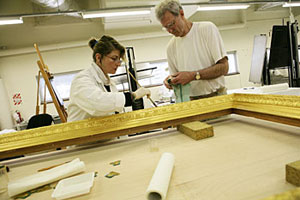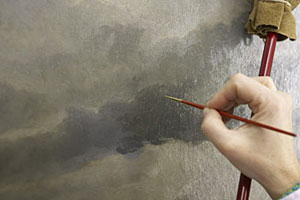Conservator
Tasks & duties

Conservators may do some or all of the following:
-
research the history of artefacts and artworks
-
analyse and test items to determine the material they are made of, their condition, and their authenticity
-
write notes on an item's condition and note any previous conservation work
-
consult with curators, owners or iwi about how to treat items
-
preserve and repair items using chemical treatments
-
keep records of completed treatment, including before and after photos of the item
-
help repair damaged items, for example, treating items that are water damaged
-
ensure exhibits are in good condition
-
advise other staff or collectors on how to store, display and transport artworks and artefacts
-
give training workshops on conservation techniques to community agencies
-
keep up to date with new developments in conservation
Specialisations
Conservators can specialise in working with:
- paintings
- paper
- books
- sculptures and objects
- buildings
- taonga Māori
- photographs
- sound recordings
Skills & knowledge

Conservators need to have knowledge of:
- art and art history
- their specialist subject area such as paper, wood or multimedia
- different treatment methods
- conservation principles and ethics
- materials used for conservation, such as adhesives
- chemistry, and how to use chemicals safely
- how to use different types of equipment
- taonga Māori and the Treaty of Waitangi
Conservators also need to have:
- good research and analytical skills to assess artworks
- good writing and communication skills
- the ability to work to deadlines
- presentation skills, if involved in training volunteers or other conservators
- problem-solving skills
Entry requirements
To become a conservator you need to have a tertiary qualification in conservation studies. Employers increasingly prefer candidates to have a Master of Arts in conservation studies. This degree is currently only available overseas, in countries such as Australia, the United Kingdom and Canada.
The nearest university offering a relevant Master of Arts is the University of Melbourne, Australia. An undergraduate degree in subjects such as cultural heritage studies, archaeology, anthropology, organic chemistry, science, art history, or fine arts is needed to enter postgraduate training.
The nearest university offering a Bachelor of Cultural Heritage, Conservation programme is the University of Canberra, Australia.
Secondary education
Secondary school subjects such as English, chemistry, history, art history, maths and art are useful for people wanting to become conservators. Study at NCEA Level 3 (Bursary) is preferred.
Tertiary education
Victoria University of Wellington's one-year Diploma in Heritage Materials is now linked to the Master of Arts (Conservation) programme offered through the University of Melbourne. Students who have completed the Diploma in Heritage Materials in Wellington will get six months' credit towards the University of Melbourne programme.
Training on the job
There are no formal internship programmes for graduate conservators in New Zealand, so recent graduates need to gain experience working in large museums or galleries overseas.
To keep up with new developments in the field, conservators may attend the annual New Zealand Conservators of Cultural Materials (NZCCM) conference. They may also go to seminars and international workshops and conferences as part of their ongoing professional development.
Useful experience
Useful experience for conservators includes:
- creating art or making craft items
- volunteer experience or work in museums, art galleries or libraries
- conservation technician work
- experience relevant to their particular speciality, such as photography for photographic conservators
Related courses
Curatorial Studies
Librarianship and Information Management
For more information, please refer to Career Services.
Document Actions
